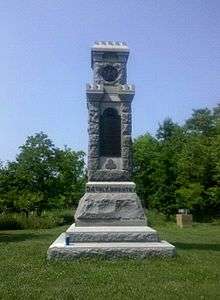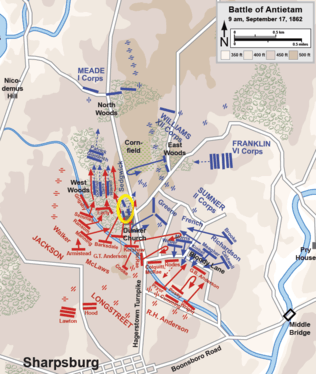34th New York Volunteer Infantry Regiment
The 34th New York Volunteer Infantry Regiment, the "Herkimer Regiment", was an infantry regiment of the Union Army during the American Civil War.
| 34th Regiment New York Volunteer Infantry | |
|---|---|
.svg.png) | |
| Active | June 15th, 1861 to June 30, 1863 |
| Country | |
| Allegiance | Union |
| Branch | Infantry |
| Engagements | Battle of Ball's Bluff Battle of Yorktown (1862) Battle of Fair Oaks Seven Days' Battles Battle of Antietam Battle of Fredericksburg Battle of Chancellorsville |
| Insignia | |
| 2nd Division, II Corps | |
Service
The regiment was organized in Albany, New York, on May 24, 1861, and was mustered in for a two-year enlistment on June 15, 1861; it was composed of five companies from Herkimer County, two from Steuben, one from Albany, one from Clinton and one from Essex County. Part of the 38th Militia entered this regiment on June 8, 1863; the regiment was mustered out of service on June 30, 1863, and those men who had signed three year enlistments were transferred to the 82nd New York.

The companies were recruited principally:
- A at West Troy;
- B at Little Falls;
- C at Graysville and Norway;
- D at Champlain;
- E at Addison;
- F and G at Herkimer;
- H at Crown Point;
- I at Hammondsport, and
- K at Salisbury.
During the Battle of Antietam, the regiment was assigned to the 1st Brigade (Willis A. Gorman commanding), 2nd Division (John Sedgwick commanding), II Corps (Edwin V. Sumner commanding).

At 7:30 on the morning of September 17, 1862, the Thirty-fourth Regiment left camp near Keedysville, crossed the Antietam Creek and marched westward into the East Woods, now extinct. Facing Westward being on the extreme left of Brigade line it emerged from the East Woods and soon became heavily engaged with the Confederate forces in its front. Crossing the open field and the Hagerstown Pike, it entered the West Woods, now also extinct, the line extending North and South of the Dunkard Church. The left of the Regiment being unprotected was in danger of being enveloped by the enemy, and a hasty retreat became necessary; the Regiment reforming near the East Woods with its organization intact. In a very brief time 43 men had been killed and 74 wounded, the killed being 13 percent of all engaged.[1]
The regiment lost 14 men killed or wounded at Fredericksburg and an additional 18 men captured.
On May 1, 1863, the day prior to the Battle of Chancellorsville, six companies of the regiment mutinied and refused to fight on the grounds that their two year enlistment terms had expired, although in fact this was still almost two months away. Brig. Gen John Gibbon, who commanded the division that the 34th New York was in, brought up the 18th Massachusetts and gave them orders to shoot the men of the 34th New York if they wouldn't fight. The regiment reformed and served dutifully during the Second Battle of Fredericksburg two days later. On June 30, the 34th New York mustered out and the two year men went home, the remaining companies, who had signed up for three years of service, being transferred to the 82nd New York Infantry.
Total strength and casualties
The total enrollment of the regiment was 1,016 members, of whom 93 were killed in action or died of wounds during the term of service and 69 died from other causes. During its service the regiment lost by death, killed in action, 1 officer, 65 enlisted men; of wounds received in action, 2 officers, 26 enlisted men; of disease and other causes, 1 officer, 67 enlisted men; total, 4 officers, 158 enlisted men; aggregate, 162.[2]
Commanders
- Colonel William LaDue
- Colonel James A. Suiter
- Colonel Byron Laflin
See also
- List of New York Civil War regiments
Notes
References
External links
- New York State Military Museum Unit History Project New York State Military Museum and Veterans Research Center - Civil War - 34th Infantry Regiment History, photographs, table of battles and casualties, and historical sketch for the 34th New York Infantry Regiment.
- Antietam National Battlefield 34th New York Infantry Monument
- Antietam on the Web 34th New York Infantry
- Antietam - The West Woods American Battlefield Trust